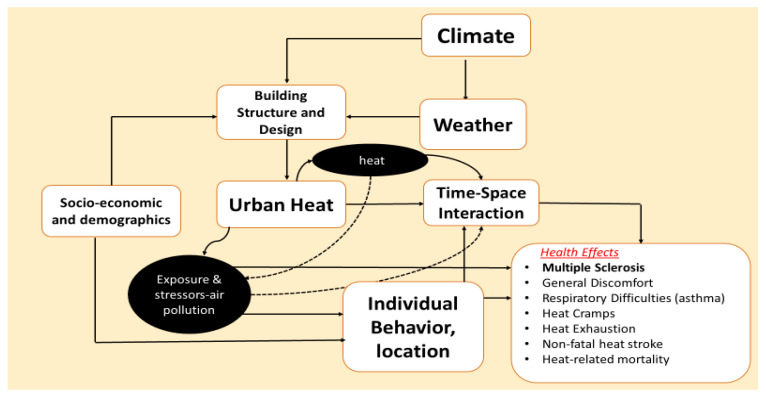VA Study Shows Increased Clinic Visits With Higher Temperatures
By Jennifer Marquez
MIAMI — While the global effects of climate change are much discussed, research now is evaluating the much more specific consequences of temperature fluctuations, including detrimental outcomes for multiple sclerosis patients.
A new veterans’ study demonstrates that heat stress is associated with an increased risk of clinic visits for patients with multiple sclerosis (MS), a neurological disorder that affects nearly one million U.S. adults. The findings have implications for the management of MS as global warming intensifies, producing more erratic weather patterns, greater variations in daily temperatures and strong heatwaves.1
While several risk factors can contribute to MS flare-ups, such as fatigue, a poor diet and certain infections, heat stress is considered one of the most important risk factors, because it can destabilize the fatty myelin sheath that insulates and protects the body’s nerve fibers. Controlling heat exposure is critical to effective management of the disease, according to the researchers.
“When this fatty layer is exposed to heat, it melts and these wires get short-circuited,” explained Naresh Kumar, PhD, corresponding author of the study, which was published in the International Journal for Environmental Research and Public Health. “It interrupts neurons signaling from different parts of the body to the brain, resulting in the exacerbation of MS symptoms.”
Although exercise-related heat stress is extensively documented as a risk factor for worsening MS symptoms, the associations between MS and ambient environmental conditions, such as temperature variation, are less established.
Climate-Specific
“In Miami, we experience year-round high humidity and temperatures, which dictate heat stress,” says Kumar, associate professor of environmental health at the University of Miami School of Medicine. “This motivated us to examine climate-region specific risk factors of MS.” He worked with Miami VAMC researchers to conduct the study.
The investigators identified more than 500,000 MS-related visits to VA clinics across the United States They then cross-referenced these medical records with meteorological data from the National Climatic Data Center (now known as the National Centers for Environmental Information) to assess how various weather conditions independently affect the risk of an MS clinic visit.
Results indicated that clinic visits varied among U.S. geographic regions and most frequently occurred in the northeast and upper Midwest. This supports previous research that shows a greater prevalence of MS among people living in colder climates, further from the equator. The study also found that clinic visits varied across seasons and were 9% more likely to take place in the spring, summer and fall months compared to winter months.2
“People living in warm or tropical areas are physiologically adapted to the heat,” Kumar told U.S. Medicine. “When exposed to high heat during warmer months, MS patients who live in colder areas are at greater risk of a clinic visit compared to those living in a warmer climate.”
Diurnal temperature variability, which indicates the degree of temperature change in a given day, was most significantly associated with MS clinic visits. The study, which is among the first to report such an association, found that one standard deviation increase in the temperature on a given day was associated with as high as a 1.6% increased likelihood of a MS clinic visit on that day.
Accordingly, the researchers suggested it is highly likely that a changing climate is already exacerbating the disease burden of MS by producing unstable weather patterns, atypically warm temperatures and a sudden increase in heat stress. Global warming might also contribute to a rising number of MS cases, although the researchers say more study is needed to determine such a link.
“It is premature to state that these weather conditions can result in the onset of the disease,” Kumar advised. “However, this possibility cannot be discounted if individuals are exposed to excessive heat stress and their body is unable to effectively regulate this heat exposure.”
Further research also is needed to investigate potential methods of managing heat sensitivity for MS patients, he said. For example, the study authors posited that thermotherapy, or heat therapy, might be useful to mitigate MS symptoms by helping patients adapt to higher temperatures.
As global temperatures continue to rise, MS patients may be increasingly vulnerable to flare-ups, which has implications for providers and patients, Kumar cautioned. “In the next phase of research, we need to identify the level, frequency, duration and type of heat exposures that can result in the onset of MS and/or associated comorbidities, and climate region-specific factors that explain variability in adaptations to different meteorological conditions.”
- Gill Chacko, Sneh Patel , Anat Galor , Naresh Kumar. Heat Exposure and Multiple Sclerosis-A Regional and Temporal Analysis. International Journal of Environmental Research and Public Health. Published June 2, 2021. DOI: 10.3390/ijerph18115962
- Vahid Kazemi Moghaddam, Mohammad Sarmadi, Maryam Tatari, Fereshteh Najafi, Amir Esmaeili, Mostafa Hadei. Epidemiology of Multiple Sclerosis in Torbat-e Heydarieh (Northeast of Iran) during 1982-2016. Multiple Sclerosis and Related Disorders. Published July 7, 2018. DOI: 10.1016/j.msard.2018.07.008


